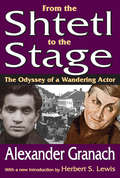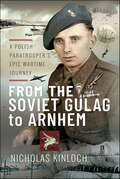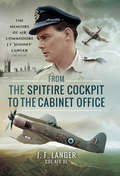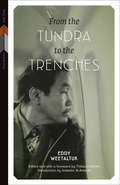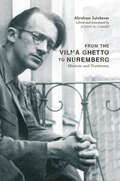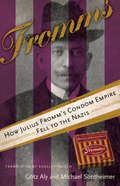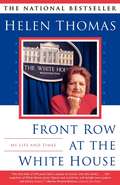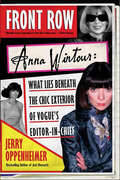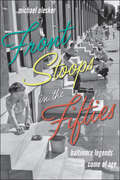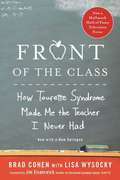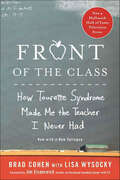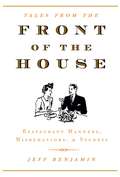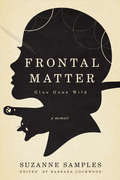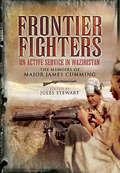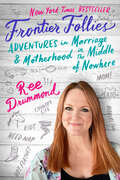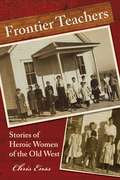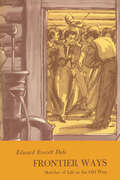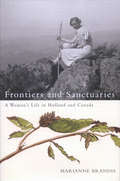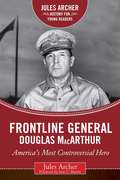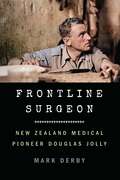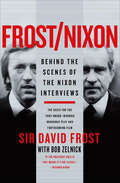- Table View
- List View
From the Shtetl to the Stage: The Odyssey of a Wandering Actor
by Alexander GranachAlexander Granach, who died while he was acting on Broadway in 1945, brilliantly relates the remarkable story of his unlikely path from a poverty-stricken, rough-and-tumble childhood to success on the German stage. This is the account of a daring, curiosity-filled, and perceptive Jewish child from poor towns in Galicia who was seized with a passion for the theater when he saw his first show at the age of 14. He overcame great odds to become a leading stage and film actor in Weimar Germany - and he had to have both legs broken to do it! Born in what is now southern Ukraine, Granach began working at the age of six in his father's bakery, where his heavy tasks left him visibly knock-kneed. With very little formal education but open for adventure and willing to work hard, Alexander ran away several times, the last time to Berlin, at the age of 16, where his talent and charm won him a place in Max Reinhardt's theater school. His career was abruptly interrupted by World War I and his time as a prisoner of war in Italy, but after a daring escape and the end of the war he resumed his rise to prominence in German artistic life. A natural storyteller, Granach's autobiography captures equally the charms, adventures, and trials of his shtetl days, the horrors of trench warfare, and the glamour and excitement of the German theater before Hitler came to power.
From the Soviet Gulag to Arnhem: A Polish Paratrooper's Epic Wartime Journey
by Nicholas KinlochAs featured on TV. The incredible true story of a teenage boy’s perilous journey around the world during World War Two. “A tale of determination and triumph” – Kay Burley, Sky News Stan was aged 15 when war broke out. Over a period of 5 years, he dodged death as he travelled thousands of kilometres from Poland to the UK, via Soviet gulags, Uzbekistan, the Middle East and India. He then trained as a paratrooper in Scotland. He met a local girl and was going to get married, but had to leave her behind when he was dropped into battle at Arnhem. He was trapped behind enemy lines and captured by the Nazis. Only the Dutch underground might be able to help him escape. This thrilling memoir is an inspiring and personal account of a triumph of resilience and courage against great odds.
From the Spitfire Cockpit to the Cabinet Office: The Memoirs of Air Commodore J F 'Johnny' Langer CBE AFC DL
by J. F. LangerAir Commodore John Langer's career has been eventful to say the least. During the Second World War he flew gliders in India in preparation for airborne assaults in Burma, one of the most perilous landscapes to pass across during this time. Post-war, he served on a fighter squadron in Germany and in Malaya, where he was recommended for an AFC. Later on, he commanded No 43 (F) Squadron, the famous 'Fighting Cocks', and was awarded the AFC. As a Group Captain, he commanded RAF Valley and was awarded the CBE. He ended his RAF career as director of Flying Training where he set up the first team of the Red Arrows. By careers end, he had flown fifty-six different types of aircraft.On leaving the RAF, he became the Civil Aviation Security Adviser to the UK Government, serving for eight years as a Crown Servant and a further seven years as a consultant. He was a frequent advisor to the Cabinet Office Briefing Room 'A' (Cobra), consulting with members of the cabinet on national and international aviation matters in the wake of a series of security and terrorist emergencies. In 1993 he was appointed Duty Lieutenant for Greater London, with responsibilities for the borough of Hillingdon, location of both Heathrow and Northolt airport. He looked after members of the Royal Family in their departures from these airports and became a good friend of Princess Diana, chaperoning her on a number of solo outings. Interesting details relating to some of their exchanges are included here. This is a unique autobiography, taking in a vast spectrum of events and experiences. It is also an important record of political, aviation and social history and should appeal to enthusiasts of all these areas of interest.
From the Streets of Shaolin: The Wu-Tang Saga
by S. H. Fernando Jr.This definitive biography of rap supergroup, Wu-Tang Clan, features decades of unpublished interviews and unparalleled access to members of the group and their associates.This is the definitive biography of rap supergroup and cultural icons, Wu-Tang Clan (WTC). Heralded as one of the most influential groups in modern music—hip hop or otherwise—WTC created a rap dynasty on the strength of seven gold and platinum albums that launched the careers of such famous rappers as RZA, GZA, Ol' Dirty Bastard, Raekwon, Ghostface Killah, Method Man, and more. During the &‘90s, they ushered in a hip-hop renaissance, rescuing rap from the corporate suites and bringing it back to the gritty streets where it started. In the process they changed the way business was conducted in an industry known for exploiting artists. Creatively, Wu-Tang pushed the boundaries of the artform dedicating themselves to lyrical mastery and sonic innovation, and one would be hard pressed to find a group who's had a bigger impact on the evolution of hip hop.S.H. Fernando Jr., a veteran music journalist who spent a significant amount of time with The Clan during their heyday of the &‘90s, has written extensively about the group for such publications as Rolling Stone, Vibe, and The Source. Over the years he has built up a formidable Wu-Tang archive that includes pages of unpublished interviews, videos of the group in action in the studio, and several notepads of accumulated memories and observations. Using such exclusive access as well as the wealth of open-source material, Fernando reconstructs the genesis and evolution of the group, delving into their unique ideology and range of influences, and detailing exactly how they changed the game and established a legacy that continues to this day. The book provides a startling portrait of overcoming adversity through self-empowerment and brotherhood, giving us unparalleled insights into what makes these nine young men from the ghetto tick. While celebrating the myriad accomplishments of The Clan, the book doesn't shy away from controversy—we're also privy to stories from their childhoods in the crack-infested hallways of Staten Island housing projects, stints in Rikers for gun possession, and million-dollar contracts that led to recklessness and drug overdoses (including Ol' Dirty Bastard's untimely death). More than simply a history of a single group, this book tells the story of a musical and cultural shift that started on the streets of Shaolin (Staten Island) and quickly spread around the world.Biographies on such an influential outfit are surprisingly few, mostly focused on a single member of the group's story. This book weaves together interviews from all the Clan members, as well as their friends, family and collaborators to create a compelling narrative and the most three-dimensional portrait of Wu-Tang to date. It also puts The Clan within a social, cultural, and historical perspective to fully appreciate their impact and understand how they have become the cultural icons they are today. Unique in its breadth, scope, and access, From The Streets of Shaolin is a must-have for fans of WTC and music bios in general.
From the Tundra to the Trenches
by Thibault Martin Eddy Weetaltuk Isabelle St. Amand“My name is Weetaltuk; Eddy Weetaltuk. My Eskimo tag name is E9-422.” So begins From the "Tundra to the Trenches." Weetaltuk means “innocent eyes” in Inuktitut, but to the Canadian government, he was known as E9-422: E for Eskimo, 9 for his community, 422 to identify Eddy. In 1951, Eddy decided to leave James Bay. Because Inuit weren’t allowed to leave the North, he changed his name and used this new identity to enlist in the Canadian Forces: Edward Weetaltuk, E9-422, became Eddy Vital, SC-17515, and headed off to fight in the Korean War. In 1967, after fifteen years in the Canadian Forces, Eddy returned home. He worked with Inuit youth struggling with drug and alcohol addiction, and, in 1974, started writing his life’s story. This compelling memoir traces an Inuk’s experiences of world travel and military service. Looking back on his life, Weetaltuk wanted to show young Inuit that they can do and be what they choose. From the Tundra to the Trenches is the fourth book in the First Voices, First Texts series, which publishes lost or underappreciated texts by Indigenous writers. This new English edition of Eddy Weetaltuk’s memoir includes a foreword and appendix by Thibault Martin and an introduction by Isabelle St-Amand.
From the Vilna Ghetto to Nuremberg: Memoir and Testimony
by Abraham SutzkeverIn 1944, the Yiddish poet Abraham Sutzkever was airlifted to Moscow from the forest where he had spent the winter among partisan fighters. There he was encouraged by Ilya Ehrenburg, the most famous Soviet Jewish writer of his day, to write a memoir of his two years in the Vilna Ghetto. Now, seventy-five years after it appeared in Yiddish in 1946, Justin Cammy provides a full English translation of one of the earliest published memoirs of the destruction of the city known throughout the Jewish world as the Jerusalem of Lithuania.Based on his own experiences, his conversations with survivors, and his consultation with materials hidden in the ghetto and recovered after the liberation of his hometown, Sutzkever’s memoir rests at the intersection of postwar Holocaust literature and history. He grappled with the responsibility to produce a document that would indict the perpetrators and provide an account of both the horrors and the resilience of Jewish life under Nazi rule. Cammy bases his translation on the two extant versions of the full text of the memoir and includes Sutzkever’s diary notes and full testimony at the Nuremberg Trials in 1946. Fascinating reminiscences of leading Soviet Yiddish cultural figures Sutzkever encountered during his time in Moscow – Ehrenburg, Yiddish modernist poet Peretz Markish, and director of the State Yiddish Theatre Shloyme Mikhoels – reveal the constraints of the political environment in which the memoir was composed.Both shocking and moving in its intensity, From the Vilna Ghetto to Nuremberg returns readers to a moment when the scale of the Holocaust was first coming into focus, through the eyes of one survivor who attempted to make sense of daily life, resistance, and death in the ghetto.A Yiddish Book Center Translation
Fromms
by Shelley Frisch Michael Sontheimer Gotz AlyIf you wanted to buy a top-quality condom in prewar Germany, you bought Fromms Act, the first brand name condom and still a leading brand in the German market. The man behind this "pure German quality product" was Julius Fromm, a Jewish entrepreneur who had immigrated from Russia as a child. Fromm was in the right place at the right time: he patented Fromms Act in 1916, when the combination of changing sexual mores, awareness of sexual health, and the lack of reliable prophylactics meant a market primed for his product. In 1922 he began mass production and opened international branches. Sixteen years later, after building the brand into a best seller and the company into a model business, he was forced to sell Fromms Act for a fraction of its worth to a German baroness. In 1939 he emigrated to London.Aly and Sontheimer trace Fromm's rise and fall, illuminating the ways Jewish businesses like his were Aryanized under the Nazis. Through the biography of this businessman and the story of his unusual and fabulously successful company, we learn the fascinating history of the first branded condoms in Germany and the sexual culture that allowed them to thrive, the heretofore undocumented machinations by which the Nazis robbed German-Jewish families of their businesses, and the tragedy of a man whose great love for the adopted country that first allowed him to succeed was betrayed by its government and his fellow citizens. This captivating account offers a wealth of detail and a fresh array of photographic documentation, and adds a striking new dimension to our understanding of this dark period in German history.From the Hardcover edition.
Fromms: How Julius Fromm's Condom Empire Fell to the Nazis
by Götz Aly Michael SontheimerIf you wanted to buy a top-quality condom in prewar Germany, you bought Fromms Act, the first brand name condom and still a leading brand in the German market. The man behind this “pure German quality product” was Julius Fromm, a Jewish entrepreneur who had immigrated from Russia as a child. Fromm was in the right place at the right time: he patented Fromms Act in 1916, when the combination of changing sexual mores, awareness of sexual health, and the lack of reliable prophylactics meant a market primed for his product. In 1922 he began mass production and opened international branches. Sixteen years later, after building the brand into a best seller and the company into a model business, he was forced to sell Fromms Act for a fraction of its worth to a German baroness. In 1939 he emigrated to London. Aly and Sontheimer trace Fromm’s rise and fall, illuminating the ways Jewish businesses like his were Aryanized under the Nazis. The authors also recount the Fromm family’s quest for reparations, one that came to an end only in 2006. Through the biography of this businessman and the story of his unusual and fabulously successful company, we learn the fascinating history of the first branded condoms in Germany and the sexual culture that allowed them to thrive, the heretofore undocumented machinations by which the Nazis robbed German-Jewish families of their businesses, and the tragedy of a man whose great love for the adopted country that first allowed him to succeed was betrayed by its government and his fellow citizens. This captivating account offers a wealth of detail and a fresh array of photographic documentation, and adds a striking new dimension to our understanding of this dark period in German history.
Front Row at the White House: My Life and Times
by Helen Thomas"I'm still here, still arriving at the White House in the wee hours of the morning, reading the papers and checking the wire, still waiting for the morning briefing, still sitting down to write the first story of the day and still waiting to ask the tough questions." From the woman who has reported on every president from Kennedy to Clinton for United Press International: a unique glimpse into the White House -- and a telling record of the ever-changing relationship between the presidency and the press. From her earliest years, Helen Thomas wanted to be a reporter. Raised in Depression-era Detroit, she worked her way to Washington after college and, unlike other women reporters who gave up their jobs to returning veterans, parlayed her copy-aide job at the Washington Daily News into a twelve-year stint as a radio news writer for UPI, covering such beats as the Department of Justice and other federal agencies. Assigned to the White House press corps in 1961, Thomas was the first woman to close a press conference with "Thank you, Mr. President," and has covered every administration since Kennedy's. Along the way, she was among the pioneers who broke down barriers against women in the national media, becoming the first female president of the White House Correspondents Association, the first female officer of the National Press Club and the first woman member, later president, of the Gridiron Club. In this revealing memoir, which includes hundreds of anecdotes, insights, observations, and personal details, Thomas looks back at a career spent with presidents at home and abroad, on the ground and in the air. She evaluates the enormous changes that Watergate brought, including diminished press access to the Oval Office, and how they have affected every president since Nixon. Providing a unique view of the past four decades of presidential history, Front Row at the White House offers a seasoned study of the relationship between the chief executive officer and the press -- a relationship that is sometimes uneasy, sometimes playful, yet always integral to democracy. "Soon enough there will be another president, another first lady, another press secretary and a whole new administration to discover. I'm looking forward to it -- although I'm sure whoever ends up in the Oval Office in a new century may not be so thrilled about the prospect."
Front Row: Anna Wintour: The Cool Life And Hot Times Of Vogue's Editor In Chief
by Jerry OppenheimerFrom the New York Times bestselling author of Just Desserts: Martha Stewart: The Unauthorized Biography comes a scrupulously researched investigative biography that tells the inside story of Anna Wintour's incredible rise to powerFrom her exclusive perch front row center, glamorous Vogue magazine editor in chief Anna Wintour is the most powerful and influential style-maker in the world. Behind her trademark sunglasses and under the fringe of her Louise Brooks bob she determines whether miniskirts are in or out, whether or not it's politically correct to wear fur. She influences designers, wholesalers, and retailers globally from Seventh Avenue to the elegant fashionista enclaves of L'Avenue Montaigne and Via della Spiga. In the U.S. alone a more than $200 billion fashion industry can rise or fall on Anna Wintour's call. And every month millions of women-and men-read Vogue, and are influenced by the pages of the chic and trendy style wish-book that she has controlled with an iron hand in a not-always-so-velvet glove since fighting her way to the most prestigious job in fashion journalism.Anna Wintour's fashion influence extends to celebrities and politicians: because of it, Hillary Clinton underwent a drastic makeover and became the first First Lady to strike a pose on the cover of Vogue in the midst of Monicagate; Oprah Winfrey was forced to go on a strict diet before Wintour would put her on Vogue's cover. And beauties like Rene Zellweger and Nicole Kidman follow Anna Wintour's fashionista rules to the letter.Now in her mid-fifties, as she nears her remarkable second decade at the helm of Vogue, comes this revealing biography that will shock and surprise both Anna's fans and detractors alike. Based on scores of interviews, Front Row unveils the Anna Wintour even those closest to her don't know. Oppenheimer chronicles this insecure and creative powerhouse's climb to the top of the bitchy, competitive fashion magazine world, showing up close, as never before exposed, how she artfully crafted and reinvented herself along the way. She's been called many things-"Nuclear Wintour," by the British press, "cold suspicious and autocratic, a vision in skinniness," by Grace Mirabella, the editor she dethroned at Vogue, and the "Devil" by those who believe she's the inspiration for a recent bestselling novel written by a former assistant.Included among the startling revelations in Front Row are: * Anna's "silver spoon" childhood spent craving time with her father. * Anna's rebellious teen years in London, obsessed with fashion, night-clubbing and dating roguish men. * Anna's many tempestuous romances. * Anna's curious marriage to a brilliant child psychiatrist, her role as a mother, and the shocking scandal that led to divorce when she had an affair with a married man.
Front Stoops in the Fifties: Baltimore Legends Come of Age
by Michael OleskerThis personal history of prominent Baltimoreans sheds light on the social transformations already taking place in the supposedly innocent 1950s. Front Stoops in the Fifties recounts the stories of some of Baltimore&’s most famous personalities as they grew up during the &“decade of conformity&”—just before they entered the turbulent 1960s. Focusing on the period before JFK&’s assassination, Olesker looks to individuals who would go on to influence the brewing cultural revolution. Such familiar names as Jerry Leiber, Nancy Pelosi, Thurgood Marshall, and Barry Levinson figure prominently in Michael Olesker&’s fascinating account, which draws on personal interviews and journalistic research. Olesker tells the story of Nancy D&’Alesandro Pelosi, daughter of the mayor, who grew up in a political home and eventually became the first woman Speaker of the House. Thurgood Marshall, schooled in a racially segregated classroom, went on to argue Brown v. Board of Education of Topeka before the U.S. Supreme Court and rewrite race-relations law. These and many other stories come to life in Front Stoops in the Fifties. &“[A] fascinating read . . . The shocking part is just how relevant these stories remain today.&” —Baltimore Post-Examiner &“[A] crisp, insightful dispatch from a skilled writer who knows his city and its history.&” —David Simon, executive producer of HBO&’s The Wire
Front of the Class: How Tourette Syndrome Made Me the Teacher I Never Had
by Brad Cohen Lisa WysockyAs a child with Tourette syndrome, Brad Cohen was ridiculed, beaten, mocked, and shunned. Children, teachers, and even family members found it difficult to be around him. As a teen, he was viewed by many as purposefully misbehaving, even though he had little power over the twitches and noises he produced, especially under stress. Even today, Brad is sometimes ejected from movie theaters and restaurants. But Brad Cohen's story is not one of self-pity. His unwavering determination and fiercely positive attitude conquered the difficulties he faced in school, in college, and while job hunting. Brad never stopped striving, and after twenty-four interviews, he landed his dream job: teaching grade school and nurturing all of his students as a positive, encouraging role model.
Front of the Class: How Tourette Syndrome Made Me the Teacher I Never Had
by Brad Cohen Lisa WysockyThe inspirational story of how one man overcome his challenges with Tourette syndrome to become Georgia’s First Class Teacher of the Year.As a child with Tourette syndrome, Brad Cohen was ridiculed, beaten, mocked, and shunned. Children, teachers, and even family members found it difficult to be around him. As a teen, he was viewed by many as purposefully misbehaving, even though he had little power over the twitches and noises he produced, especially under stress. Even today, Brad is sometimes ejected from movie theaters and restaurants.But Brad Cohen’s story is not one of self-pity. His unwavering determination and fiercely positive attitude conquered the difficulties he faced in school, in college, and while job hunting. Brad never stopped striving, and after twenty-four interviews, he landed his dream job: teaching grade school and nurturing all of his students as a positive, encouraging role model. Now a Hallmark Hall of Fame Movie Event available on streaming platformsFront of the Class is now in e-book format for the first time and includes a new epilogue.
Front of the House
by Jeff BenjaminIn the bestselling tradition of Restaurant Man and Setting the Table, Front of the House is a revealing and wryly humorous behind-the-scenes look at the gracious art of great restaurant service. Great restaurant service is a gracious art that's been studied, practiced and polished by Jeff Benjamin, two-time James Beard Award nominee and managing partner of Philadelphia's acclaimed Vetri family of restaurants. Sagacious and observant, he beckons us behind the scenes for an insider's look at reserving a table, what your server thinks of you, what it takes to get ejected from a fine restaurant and a host of other revelations.
Frontal Matter: Glue Gone Wild
by Barbara Lockwood Suzanne SamplesA fun, funny, and heartbreakingly real memoir of a woman's fight against terminal brain cancer. The writing is honest, charming, and full of cuss words.Suzanne Samples teaches English at Appalachian State University in Boone, North Carolina. She was diagnosed with a frontal lobe glioblastoma multiforme at 36. She loves roller derby and lives on the side of a mountain with her pets Gatsby, Prufrock, and Duffles.Featured in swag bags for the 2019 Golden Globe presenters and nominees.
Frontier Fighters: The Memoirs of Major James Cumming
by Walter CummingsThese are fascinating memoirs of a British officer who fought the legendary Pathan tribesmen of the Northwest Frontier, right up to the beginning of WW2. He describes desperate battles against this highly skilled and ruthless enemy. Pathan atrocities were commonplace and no prisoners were taken.Cummings served in two Frontier units, the South Waziristan Scouts and the Corps of Guides. Waziristan, then the home of Wazirs and Mahsuds, the most war like of Pathan tribes, is today sanctuary for Al Qaeda and Taliban terrorists. Frontier Fighters describes the closing stages of Britains imperial presence on the subcontinent. Yet beside the pig sticking, polo and hunting, there was great excitement danger and gallantry. A unique bond existed between the British and their native troops. Paradoxically Cummings went on to command a Pathan regiment in North Africa in WW2.
Frontier Follies: Adventures in Marriage and Motherhood in the Middle of Nowhere
by Ree DrummondA down-to-earth, hilarious collection of stories and musings on marriage, motherhood, and country life from the #1 New York Times bestselling author and star of the Food Network show The Pioneer Woman, Ree Drummond.In this relatable, charming book, Ree unveils real goings-on in the Drummond house and around the ranch. In stories brimming with the lively wit and humor found in her cookbooks and her bestselling love story, The Pioneer Woman: Black Heels to Tractor Wheels, Ree pulls back the curtain and shares her experiences with childbirth, wildlife, isolation, teenagers, in-laws, and a twenty-five-year marriage to a cowboy/rancher.A celebration of family life, love, and (mostly) laughter, Frontier Follies is a keepsake to curl up with, have a good laugh, and remember all that’s wonderful (and funny) about family.
Frontier Teachers: Stories of Heroic Women of the Old West
by Chris EnssFrontier Teachers tells the stories of a dozen courageous, intrepid women who faced down rooms full of children on the open prairies and in the mining towns of the Old West to bring them educational opportunities.
Frontier Ways: Sketches of Life in the Old West (Personal Narratives of the West)
by Edward Everett DaleThe classic account of what day-to-day life was like for cowboys and pioneer families in the American West. Born in a log cabin in 1879—Edward Everett Dale sought education and become a prolific and versatile professional writer—but always remained rooted in his close connection to the frontier. He lived in a sod house, and once rode the range as cook to a group of cowboys. His life experiences brought exceptional authenticity to his work, including this classic first-hand account of the way pioneers lived. In Frontier Ways he describes all aspects of frontier life: the building of a home, the problems of finding wood and water, the procuring and cooking of food, medical practices, and the cultural, social, and religious life of pioneer families. Lively and involving, this collection of his essays has allowed generations of readers to look back on the West&’s fascinating past. &“At times [Dale] was the serious scholarly research-bent historian, but more often he was the folklorist, humorist, on-the-spot frontier reporter.&” —Great Plains Journal
Frontiers and Sanctuaries
by Marianne BrandisDrawing from her mother's diaries, letters, newspaper columns, fiction, and historical works in English and Dutch, Marianne reconstructs Madzy's upper-middle-class childhood and youth in Holland before World War II, her struggle to keep herself and her small children alive during the war, and her emigration to Canada with her family in 1947. In addition to describing Madzy's participation in historic events, Marianne also explores her mother's inner life. Frontiers and Sanctuaries is most powerful in showing how Madzy's lively, creative temperament allowed her to adapt to war, a new language and culture, pioneer life, and crippling rheumatoid arthritis.
Frontiers and Sanctuaries: A Woman's Life in Holland and Canada
by Marianne BrandisDrawing from her mother's diaries, letters, newspaper columns, fiction, and historical works in English and Dutch, Marianne reconstructs Madzy's upper-middle-class childhood and youth in Holland before World War II, her struggle to keep herself and her small children alive during the war, and her emigration to Canada with her family in 1947. In addition to describing Madzy's participation in historic events, Marianne also explores her mother's inner life. Frontiers and Sanctuaries is most powerful in showing how Madzy's lively, creative temperament allowed her to adapt to war, a new language and culture, pioneer life, and crippling rheumatoid arthritis.
Frontline General: America's Most Controversial Hero (History for Young Readers)
by Jules Archer Iain C. MartinAt twenty-six Douglas MacArthur was military aide to President Theodore Roosevelt, and his courageous leadership of the Rainbow Division in World War I made him a general. At the same time, his reluctance to heed any authority but his own gained him a reputation of arrogance and insubordination that was to shadow his entire career.As MacArthur helped guide defeated Japan to democracy, it was remarked that he himself tolerated no democratic questioning of his commands. When he was summoned from Japan to take command of the desperately beleaguered forces in Korea, the conflict between duty and pride brought his career to a dramatic conclusion. With brilliant generalship he saved his army from defeat, only to be removed from his post when he refused to obey the president himself. Douglas MacArthur’s deeds were of heroic proportion, but he is, and will continue to be, one of America’s most controversial figures.
Frontline Surgeon: New Zealand Medical Pioneer Douglas Jolly
by Mark DerbyAlthough a young doctor when he volunteered for the Spanish Civil War in late 1936, New Zealander Douglas Jolly swiftly acquired a reputation as one of the most gifted and energetic surgeons of the Republican Army&’s medical services. Over the next two years he performed countless life-saving operations on wounded combatants from both sides of the conflict, as well as on civilians. Tireless, dedicated, and courageous, he developed significant and innovative treatment systems based on the principle of working as near as possible to the front line. Jolly used this unprecedented battlefield experience to write a manual that was widely used in World War II and the Korean and Vietnam Wars.Frontline Surgeon traces Jolly&’s remarkable career from medical training in 1920s New Zealand, postgraduate study during the rise of fascism in Europe, almost a decade of frontline surgery, and into civilian life as medical director of Britain&’s largest hospital for amputees. One of the greatest war surgeons of the twentieth century, Jolly has been mysteriously omitted from the ranks of pioneers of modern medicine. This engaging biography, intensively researched in many countries, both explains and redresses that omission.
Frontline and Experimental Flying With the Fleet Air Arm
by Geoffrey HiggsThe first Royal Navy pilot to fly transatlantic non-stop (in a Buccaneer) describes his thirty-five-year career in the Fleet Air Arm and as an Empire Test Pilot. The spectacle of Alan Cobham&’s Flying Circus and the Fleet at anchor in Weymouth inspired the author&’s lifelong passion for aeroplanes, flying and the Royal Navy. World War Two provided the opportunity to fulfil his ambition and at eighteen he volunteered for the Fleet Air Arm as a pilot. Training in Canada began a Naval flying career that spanned thirty-years. Front line squadron service, embarked on aircraft carriers was followed by qualification as a flying instructor. Selection for the Empire Test Pilots School at Farnborough and qualification as an experimental Test Pilot changed the direction of his naval career. In all he flew nearly one hundred types of aircraft and carried out close to a thousand deck landings. Initial flight testing of several new naval aircraft, as well as research flying in support of the development of aircraft such as the English Electric Lightning and Concorde added to a unique career. Such a long and varied period of flying was not without the inevitable mishaps. A near catastrophic catapult launch of a new naval aircraft, the jamming of the power control system in a research aircraft and hazardous flying through tropical storms at supersonic speeds to determine safety factors for Concorde&’s intended Far East route were some of the dangers of flying at the cutting edge. As pilot, he flew the first Royal Naval aircraft to cross the Atlantic non-stop without in-flight refuelling or navigational aids. He describes the fascinating ten-day flight from Croydon to Rangoon across Europe, the Middle East, Pakistan and India to deliver a Percival Provost trainer to the Burmese Air Force.Praise for Frontline and Experimental Flying with the Fleet Air Arm &“Follow Higgs from one cockpit/conference room/country to another. You&’ll be as surprised as he is that he lived to tell about some of these adventures.&” —Speedreaders &“This hefty [book] chronicles . . . a life crammed with flying all types of aircraft, mostly shipboard, and the inevitable mishaps. . . . A good read, particularly for those of us who soak up anything to do with ships and aircraft. The shipboard accounts of catapult trials, amongst other sections, are gripping, and the times in Singapore and the Far East add to the appeal, as do the various accounts of life alongside the Americans. Geoffrey Higgs flew nearly 100 different types of aircraft in his career and his love of flying shines through the pages.&” —Alan Rawlinson
Frost/Nixon: Behind the Scenes of the Nixon Interviews
by David Frost Bob ZelnickThe British journalist recounts his 1977 interview with the disgraced American president—the basis for the Tony Award–winning play & Oscar-nominated film.In Frost/Nixon, Sir David Frost tells the extraordinary story of how he pursued and landed the biggest fish of his career—and how the series drew larger audiences than any news interview ever had in the United States, before being shown all over the world.This is Frost’s absorbing story of his pursuit of Richard Nixon, and is no less revealing of his own toughness and pertinacity than of the ex-President’s elusiveness. Frost’s encounters with such figures as Swifty Lazar, Ron Ziegler, potential sponsors, and Nixon as negotiator are nothing short of hilarious, and his insight into the taping of the programs themselves is fascinating.Frost/Nixon provides the authoritative account of the only public trial that Nixon would ever have, and a revelation of the man’s character as it appeared in the stress of eleven grueling sessions before the cameras. Including historical perspective and transcripts of the edited interviews, this is the story of Sir David Frost’s quest to produce one of the most dramatic pieces of television ever broadcast, described by commentators at the time as “a catharsis” for the American people.
